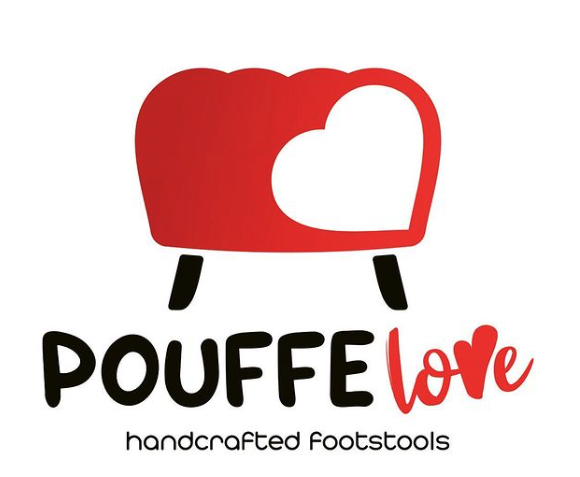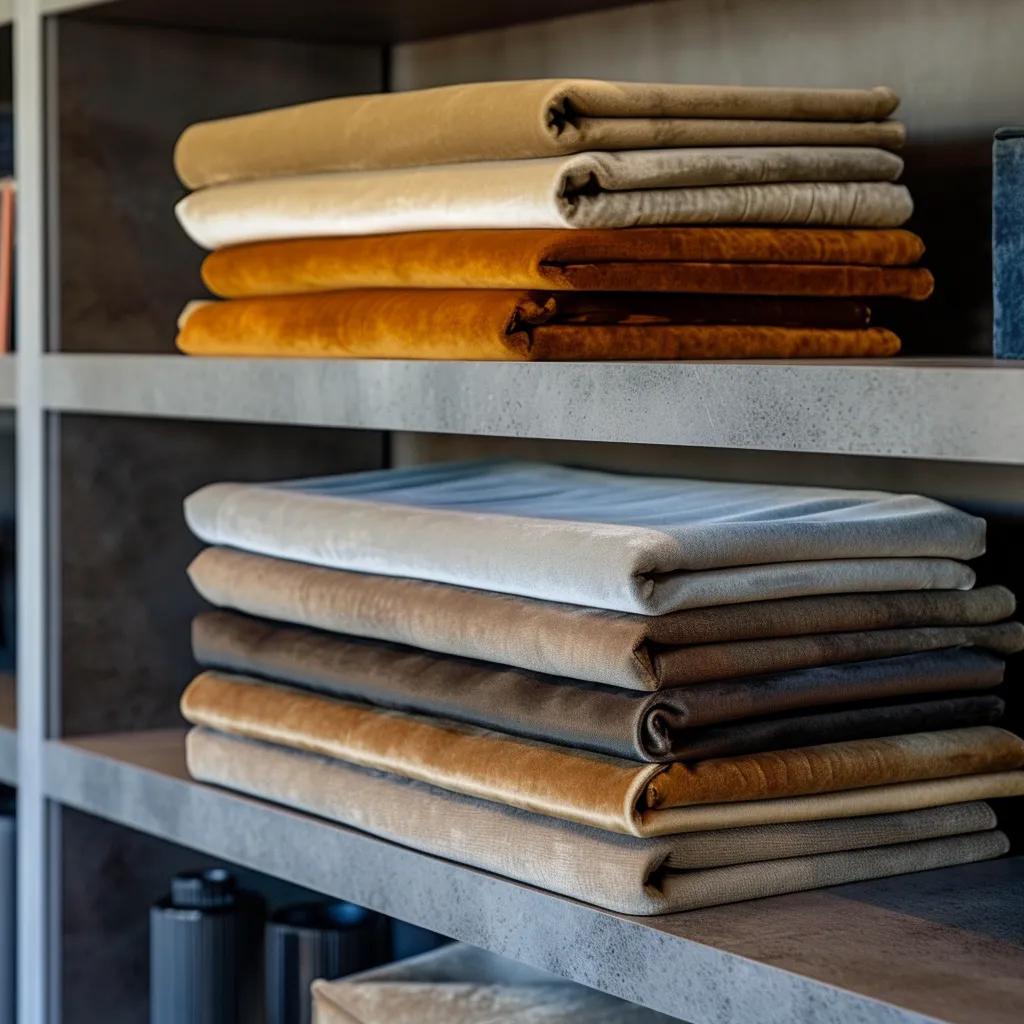
The Ultimate Guide to Choosing Upholstery Materials: Velour vs Eco-Leather for Irish Homes
When furnishing your home, selecting the right upholstery material can transform not only the aesthetic appeal of your space but also determine the longevity, comfort, and maintenance requirements of your furniture investment. In Ireland’s unique climate and lifestyle context, understanding the fundamental differences between luxurious velour and practical eco-leather becomes essential for making informed decisions that will serve your family for years to come.
This comprehensive guide explores the distinctive characteristics of these two popular upholstery materials, examining their suitability for different rooms and lifestyles. Whether you’re furnishing a bustling family living room or creating a serene bedroom sanctuary, the material choice you make will significantly impact your daily comfort and long-term satisfaction with your furniture pieces.
Understanding Velour: The Epitome of Luxury and Comfort
Velour, often confused with velvet, represents one of the most luxurious upholstery options available in today’s furniture market. This sumptuous fabric is characterized by its dense, soft pile that creates a distinctive tactile experience and visual depth that immediately elevates any piece of furniture. The manufacturing process involves creating thousands of tiny loops that are then cut to form the characteristic plush surface that velour is renowned for.
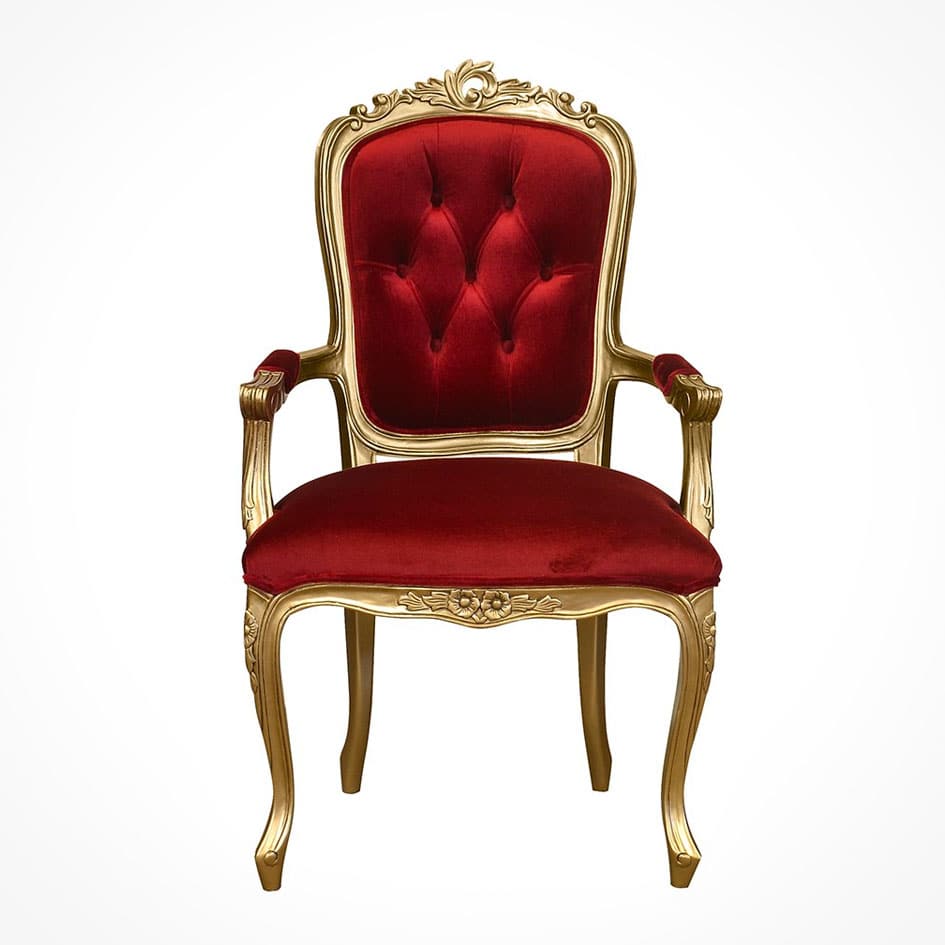
Louis XV style bedroom chair with gold frame and plush red velvet upholstery
The appeal of velour extends far beyond its visual beauty. This material offers exceptional comfort due to its soft, yielding surface that feels wonderful against the skin. The dense pile structure provides natural cushioning, making velour-upholstered furniture particularly inviting for relaxation and extended periods of use. Additionally, velour’s ability to catch and reflect light creates a dynamic visual effect, with the fabric appearing to change tone and depth depending on the viewing angle and lighting conditions.
From a design perspective, velour brings an undeniable sense of opulence to any interior space. Its rich texture and lustrous appearance make it a favorite among interior designers seeking to create focal points or add touches of luxury to residential and commercial spaces. The material works exceptionally well in traditional, classic, and even contemporary design schemes, proving its versatility across different aesthetic approaches.
However, velour’s luxurious nature comes with specific care requirements that potential buyers must consider. The dense pile can attract dust, pet hair, and lint more readily than smoother surfaces, necessitating regular maintenance to preserve its appearance. The fabric’s texture also means that spills and stains can be more challenging to address, as liquids may penetrate deeper into the pile structure.
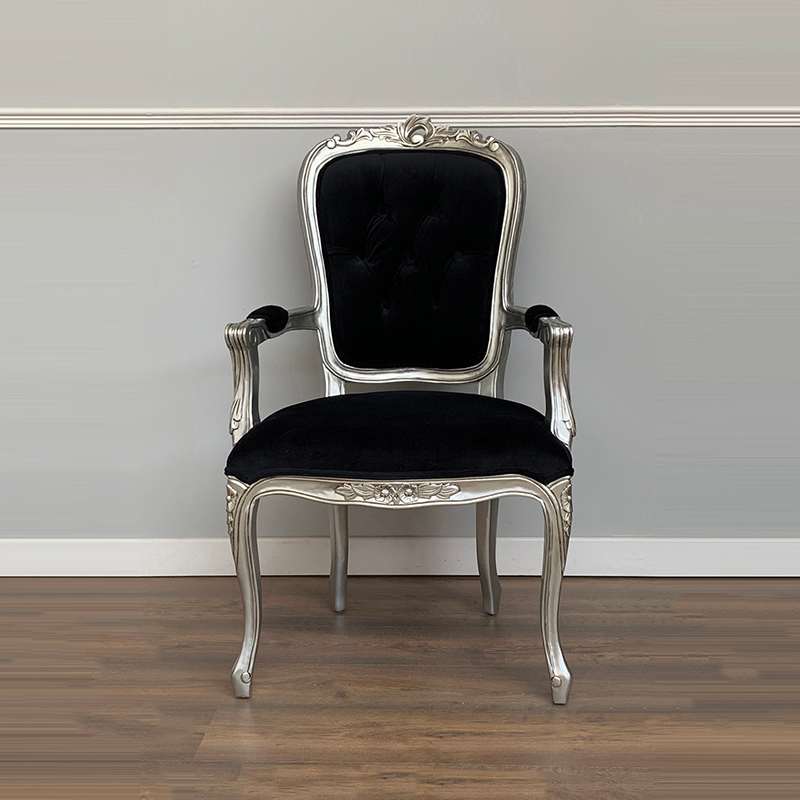
Louis XV style bedroom chair with silver leaf frame and black velour velvet upholstery
Eco-Leather: Modern Practicality Meets Sophisticated Style
Eco-leather represents a significant advancement in synthetic upholstery materials, offering many of the aesthetic benefits of genuine leather while providing enhanced practicality and environmental considerations. This innovative material is manufactured using polyurethane-based processes that create a surface remarkably similar to natural leather in both appearance and texture, yet with distinct advantages that make it particularly suitable for contemporary lifestyles.
The production of eco-leather involves sophisticated manufacturing techniques that result in a material with uniform thickness, consistent coloration, and predictable performance characteristics. Unlike genuine leather, which can vary significantly in quality and appearance due to natural variations in animal hides, eco-leather provides consistency that many furniture manufacturers and consumers appreciate.
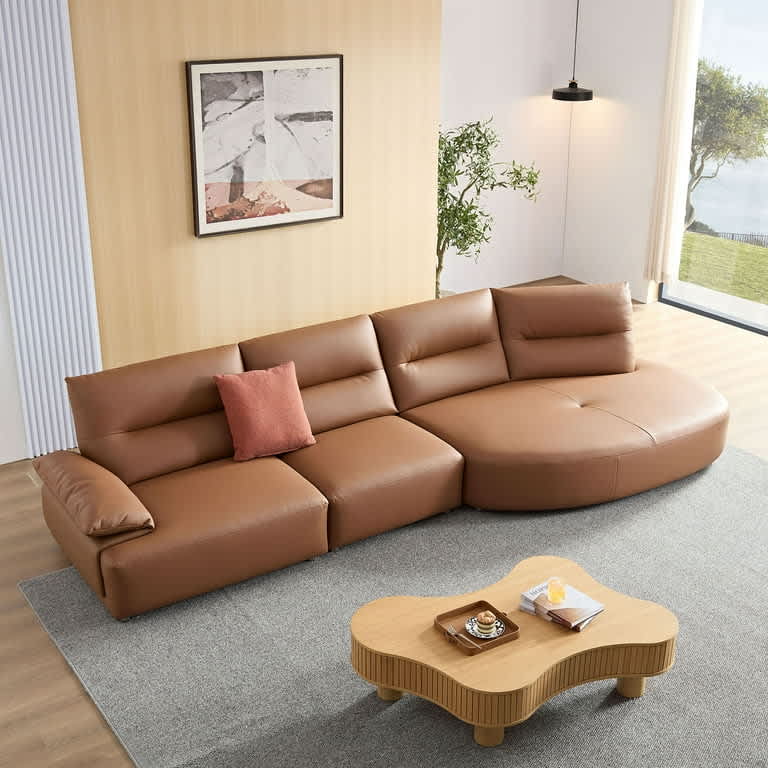
Modern curved eco-leather sectional sofa in a stylish living room setting with complementary furniture and decor
One of eco-leather’s most significant advantages lies in its maintenance characteristics. The non-porous surface resists liquid penetration, making spill cleanup significantly easier than with many fabric alternatives. This property makes eco-leather particularly attractive for families with children or pet owners who need furniture that can withstand the occasional accident without permanent damage.
From a durability standpoint, eco-leather demonstrates impressive resistance to cracking, fading, and general wear when compared to many traditional upholstery options. The material doesn’t require the conditioning treatments that genuine leather demands, and it maintains its appearance with minimal intervention beyond regular cleaning.
The environmental considerations of eco-leather also appeal to increasingly conscious consumers. The manufacturing process doesn’t involve animal products, addressing ethical concerns while often utilizing recycled materials in the production process. For Irish consumers who prioritize sustainability, eco-leather represents a responsible choice that doesn’t compromise on style or functionality.
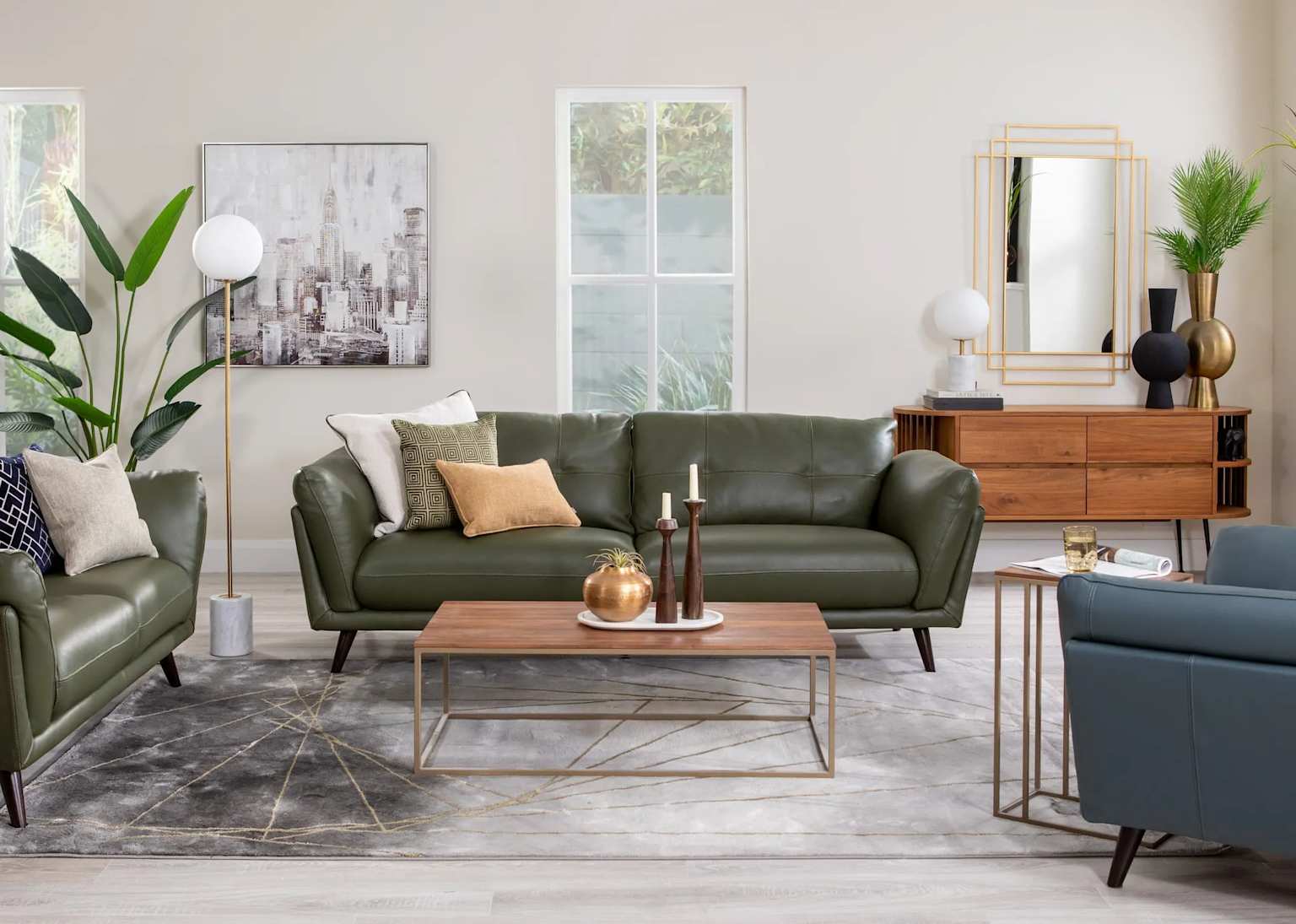
Modern living room featuring eco leather upholstered green sofas and stylish wooden furniture
Living Room Considerations: Where Durability Meets Style
The living room serves as the heart of most Irish homes, functioning as a space for family gatherings, entertainment, and daily relaxation. This high-traffic environment places specific demands on furniture that must be carefully considered when selecting upholstery materials. The choice between velour and eco-leather for living room furniture involves balancing aesthetic preferences with practical requirements that align with how the space will be used.
Living rooms typically experience the highest furniture usage in the home, with sofas and chairs serving multiple family members throughout the day. Children playing, pets lounging, and guests visiting all contribute to the wear patterns that living room furniture must endure. In this context, the material’s ability to maintain its appearance despite regular use becomes paramount.
Eco-leather emerges as the superior choice for most living room applications due to its exceptional durability and ease of maintenance. The material’s resistance to stains, scratches, and general wear makes it ideally suited for the demands of family life. When accidents occur – and in active households, they inevitably will – eco-leather’s non-porous surface allows for quick cleanup that prevents permanent damage.
The practical advantages of eco-leather extend beyond just stain resistance. The material doesn’t trap allergens like dust mites or pet dander, making it an excellent choice for family members with sensitivities. Regular cleaning requires nothing more than a damp cloth and mild cleaning solution, making maintenance both simple and cost-effective.
From a design perspective, eco-leather offers versatility that works well with the diverse functions of living spaces. Its clean, contemporary appearance complements modern Irish home designs while providing the sophistication that many homeowners desire. The material’s ability to maintain its appearance over time ensures that living room furniture continues to look fresh and inviting despite heavy use.
However, this doesn’t mean velour has no place in living room design. In formal living spaces or homes where furniture receives lighter use, velour can provide an unmatched level of luxury and comfort. The key lies in honest assessment of how the space will be used and selecting materials accordingly.
Bedroom Applications: Prioritizing Comfort and Atmosphere
The bedroom represents a fundamentally different environment from the living room, with distinct priorities that influence material selection. Here, comfort takes precedence over durability, and the ability to create a serene, luxurious atmosphere becomes as important as practical considerations. The bedroom’s lower-traffic nature allows for material choices that might not be practical in more active areas of the home.
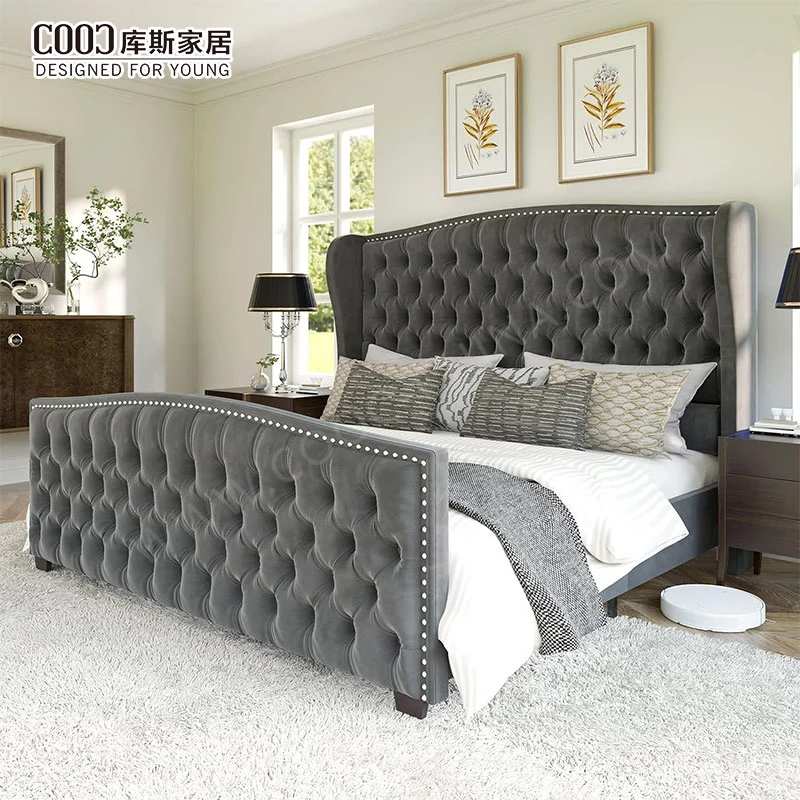
Modern bedroom with a luxurious tufted velvet upholstered bed frame featuring a high wingback headboard and matching footboard .
Velour shines in bedroom applications, where its exceptional comfort and luxury appeal create the perfect environment for rest and relaxation. The material’s soft texture feels wonderful against skin, making it ideal for headboards where contact is common. The psychological impact of velour’s luxurious appearance also contributes to creating a bedroom atmosphere that feels like a personal retreat from daily stresses.
The bedroom’s controlled environment works in velour’s favor regarding maintenance concerns. Unlike living room furniture, bedroom pieces like headboards, accent chairs, and ottomans experience minimal direct contact and are less likely to encounter spills or heavy wear. This reduced exposure allows velour’s beauty to be enjoyed with fewer concerns about the intensive maintenance that might be required in high-traffic areas.
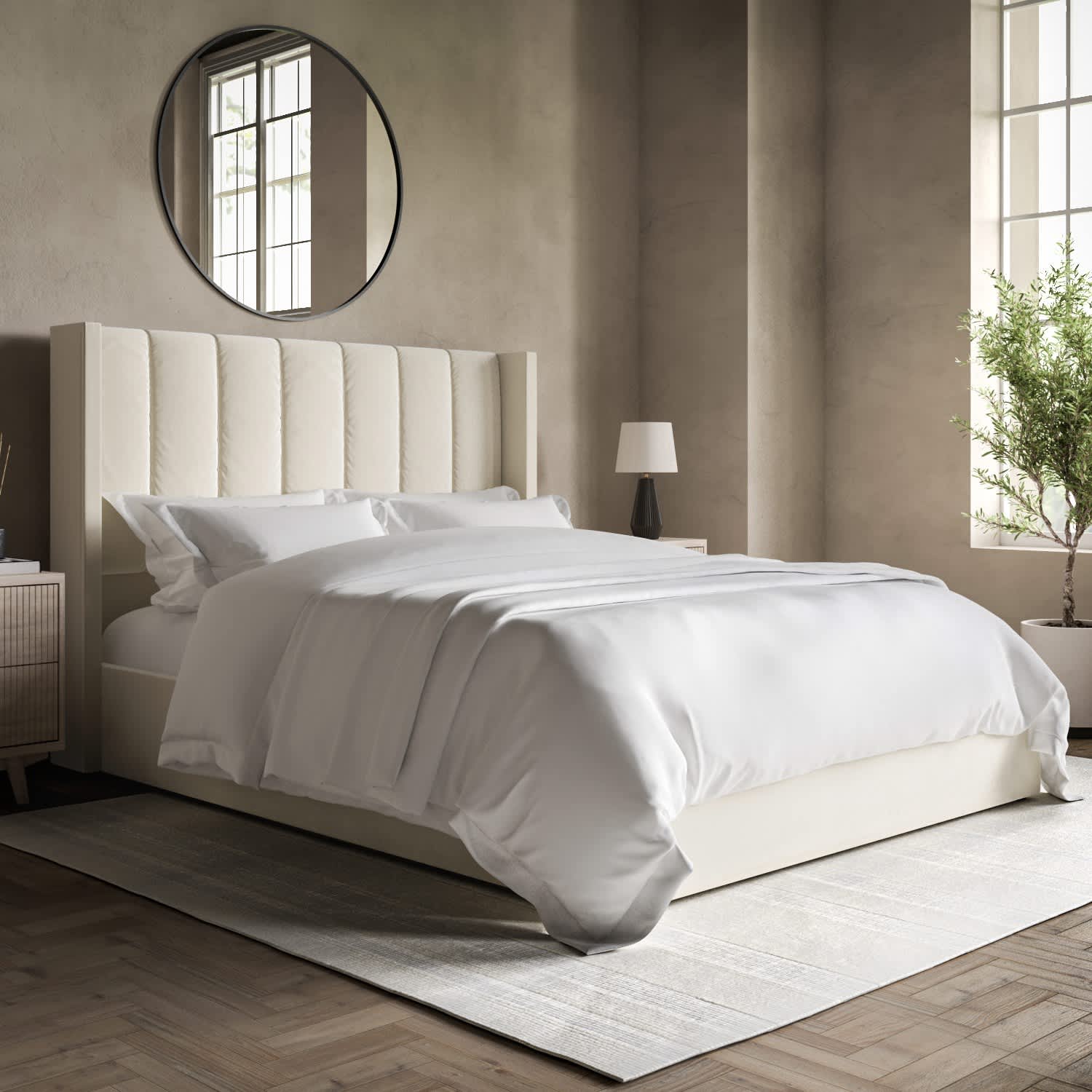
Cream velvet king-size ottoman bed with winged headboard in a modern bedroom setting
Temperature regulation represents another consideration where velour demonstrates advantages in bedroom settings. The material’s natural breathability helps maintain comfort throughout Ireland’s varying seasonal temperatures, neither retaining heat excessively in warmer months nor feeling cold to the touch during winter periods.
The sensory experience of velour also contributes to better sleep quality. The material’s soft texture and visual warmth create a cocoon-like environment that promotes relaxation and rest. For those who spend time reading or relaxing in bed, velour-upholstered headboards provide comfortable support that enhances the bedroom’s functionality as a retreat space.
While eco-leather can certainly be used in bedroom applications, it lacks the tactile warmth and luxury feel that many people desire in their personal sanctuary. The material’s more clinical appearance, while perfectly appropriate for living spaces, may feel too stark for the intimate environment that most people prefer in their bedrooms.
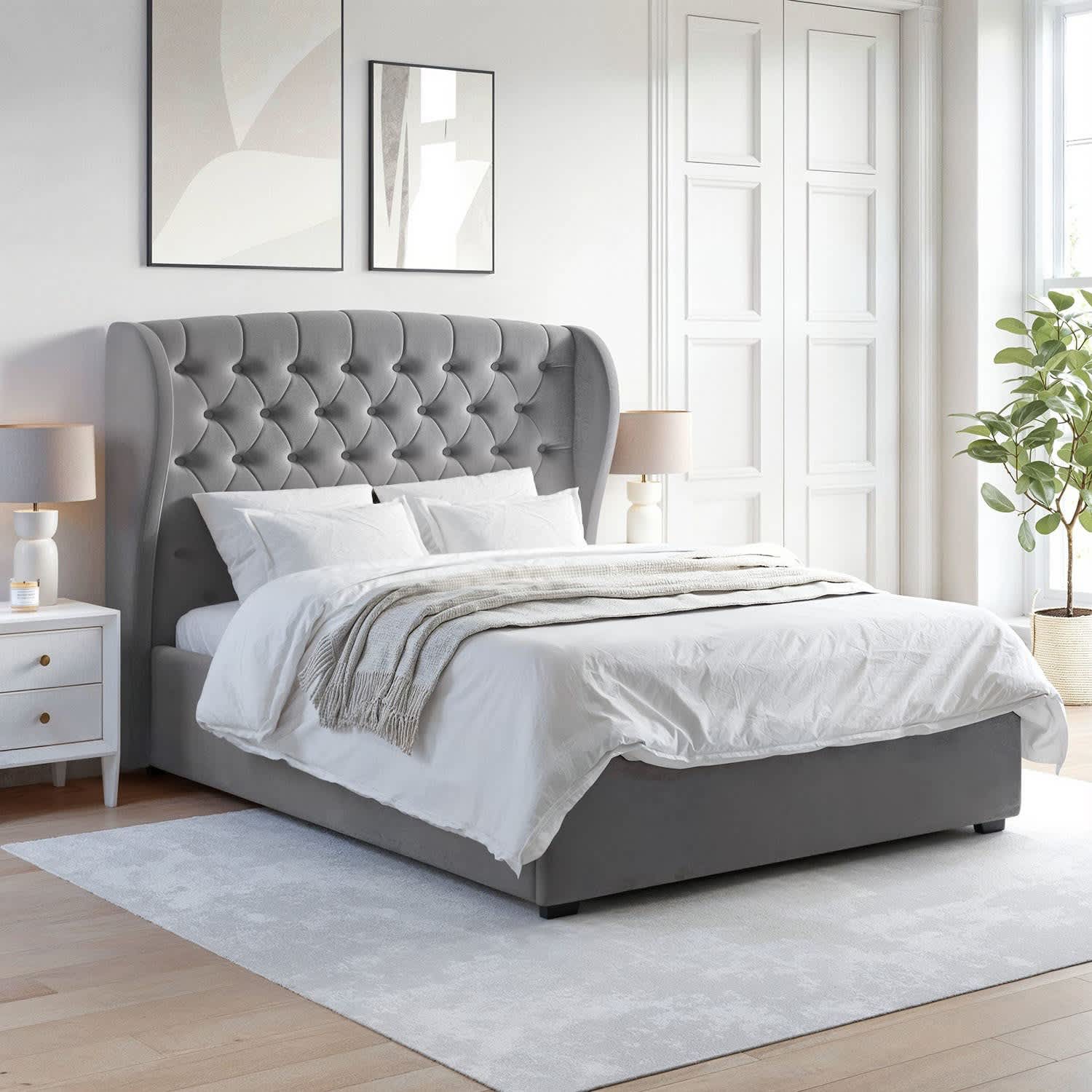
Modern bedroom featuring a grey velvet king-size ottoman bed with a tufted winged headboard and complementary white furniture
Comparative Analysis: Performance Characteristics
Understanding the specific performance characteristics of velour and eco-leather provides the foundation for making informed furniture decisions. Each material excels in different areas, and recognizing these strengths allows consumers to align their choices with their specific needs and lifestyle requirements.
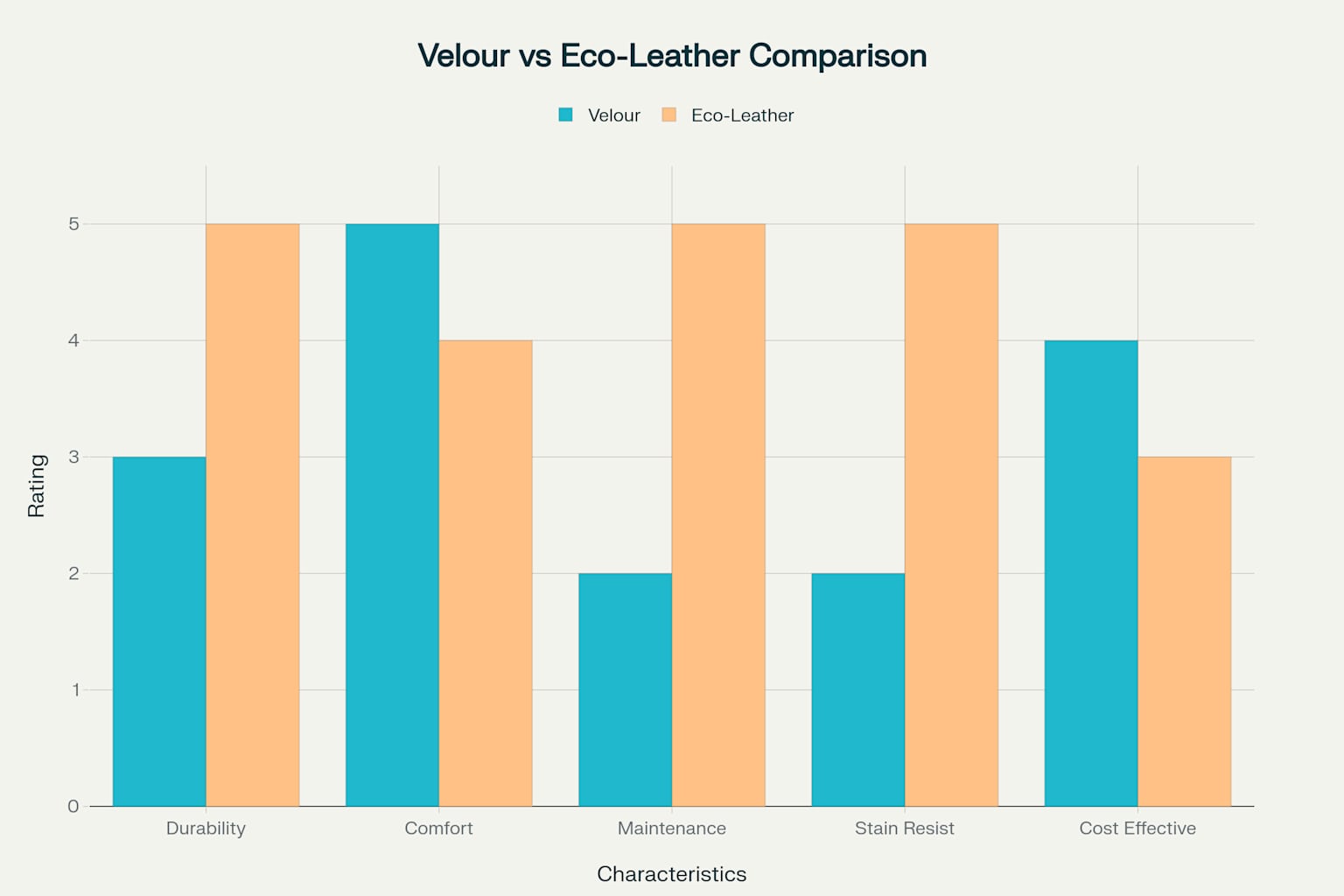
Comparison chart showing key characteristics of velour versus eco-leather upholstery materials
Durability represents one of the most significant differentiators between these materials. Eco-leather demonstrates superior resistance to wear, maintaining its appearance even under challenging conditions. The material’s construction prevents the crushing and matting that can affect pile fabrics over time. In contrast, velour, while durable when properly maintained, requires more careful handling to preserve its characteristic texture and appearance.
Comfort levels favor velour significantly, with its plush surface providing unmatched tactile appeal. The material’s ability to conform to body contours and provide cushioning makes it exceptionally comfortable for extended contact. Eco-leather, while comfortable, offers a firmer surface that some may find less inviting for prolonged relaxation.
Maintenance requirements clearly favor eco-leather, with its smooth surface allowing for easy cleaning and spot treatment. Regular maintenance involves simple wiping with appropriate cleaners, and most spills can be addressed immediately without special techniques or professional intervention. Velour demands more attention, requiring regular vacuuming, careful spot cleaning, and professional cleaning for major stains.
Stain resistance strongly favors eco-leather due to its non-porous surface that prevents liquid penetration. Most spills remain on the surface where they can be quickly addressed. Velour’s pile structure can trap liquids and debris, making stain prevention and removal more challenging and sometimes requiring professional treatment.
Cost-effectiveness varies depending on the evaluation timeframe. Velour often offers better initial value, with quality options available at competitive prices. However, the long-term costs associated with maintenance and potential replacement must be considered. Eco-leather, while potentially more expensive initially, often proves more economical over time due to lower maintenance costs and longer lifespan.
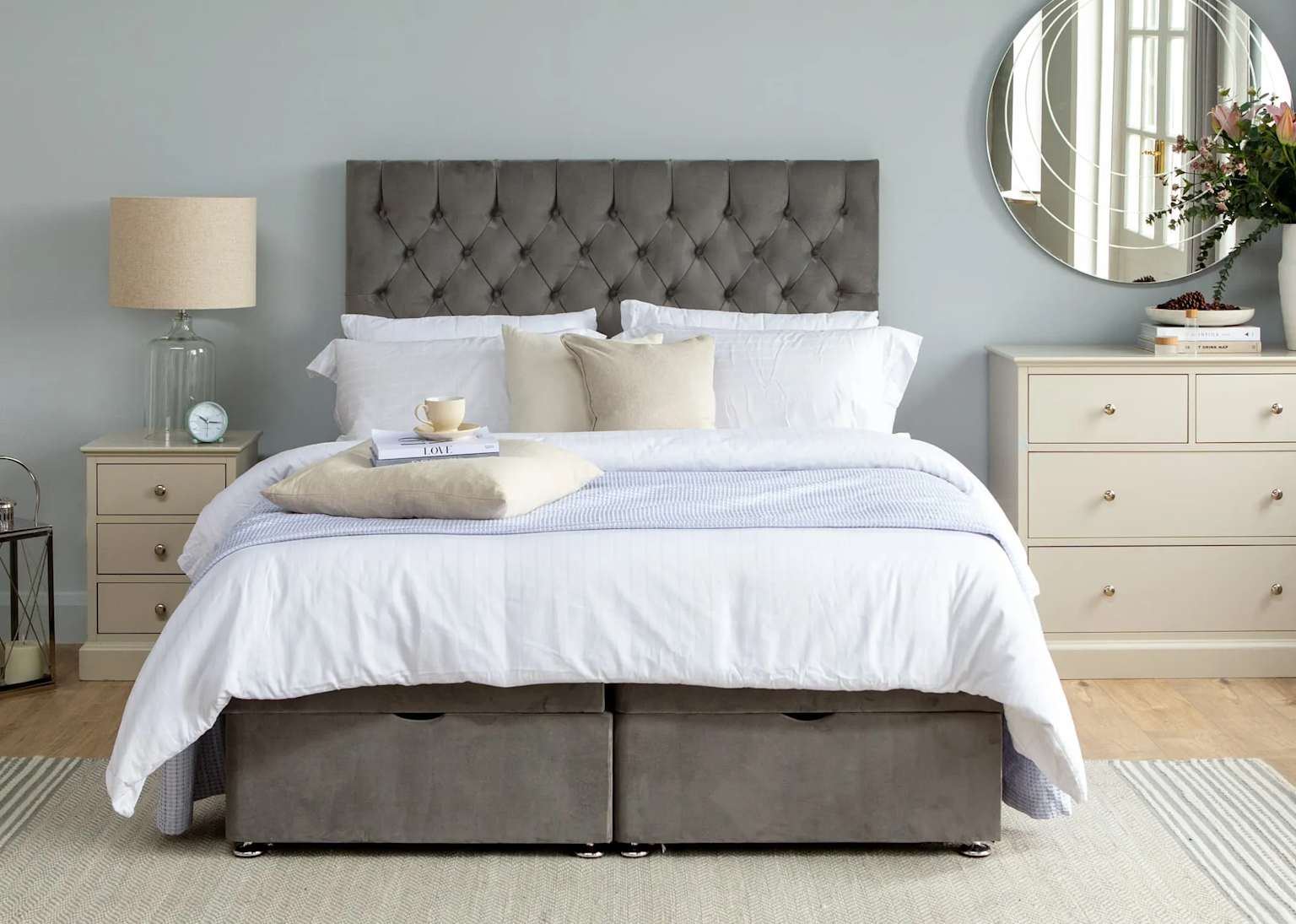
Grey velour velvet tufted headboard on a neatly made bed in a softly decorated bedroom
Care and Maintenance: Preserving Your Investment
Proper care and maintenance represent crucial factors in maximizing the lifespan and appearance of upholstered furniture, regardless of material choice. Understanding the specific requirements of velour and eco-leather allows furniture owners to develop appropriate care routines that preserve their investment while minimizing long-term costs.
Velour maintenance requires consistent attention to prevent the accumulation of dust and debris that can dull its appearance and damage the pile structure. Regular vacuuming using appropriate attachments helps maintain the fabric’s texture while removing surface contaminants. The technique involves gentle, systematic coverage that follows the pile direction to avoid damage.
Immediate attention to spills represents critical velour care protocol. Blotting rather than rubbing prevents liquids from penetrating deeper into the pile, while working from the spill’s edges toward the center prevents spreading. Professional cleaning may be necessary for significant stains or periodic deep cleaning to maintain optimal appearance.
Environmental factors significantly impact velour’s longevity. Direct sunlight can cause fading and fiber degradation, making strategic furniture placement important. Humidity control helps prevent mold and mildew issues while maintaining the fabric’s integrity. Regular rotation of cushions and periodic professional cleaning extend the material’s lifespan considerably.
Eco-leather maintenance proves substantially simpler, requiring primarily regular cleaning with appropriate products designed for synthetic leather. The non-porous surface allows for easy spot cleaning, with most spills addressed using mild soap solutions and soft cloths. Unlike genuine leather, eco-leather doesn’t require conditioning treatments, simplifying the care routine significantly.
Preventive measures for eco-leather focus primarily on avoiding sharp objects that might puncture or scratch the surface. While the material demonstrates good resistance to normal wear, deliberate damage from pets’ claws or sharp objects can cause permanent problems. Regular inspection for early signs of wear allows for prompt attention that prevents minor issues from becoming major problems.
Both materials benefit from protection against extreme temperature variations and direct sunlight exposure. While eco-leather shows better resistance to environmental factors than velour, both perform best when protected from harsh conditions that can accelerate aging and deterioration.
Irish Market Trends and Consumer Preferences
The Irish furniture market reflects broader European trends while maintaining distinct characteristics influenced by local lifestyle patterns, climate considerations, and cultural preferences. Understanding these market dynamics provides valuable context for material selection decisions that align with both personal preferences and potential resale considerations.
Recent market analysis indicates growing interest in sustainable and practical furniture solutions among Irish consumers. This trend favors eco-leather options, particularly among younger demographics who prioritize environmental responsibility alongside functionality. The material’s ethical production methods and reduced environmental impact resonate with consumers increasingly concerned about their purchasing decisions’ broader implications.
Irish climate conditions also influence material preferences, with the country’s humidity and temperature variations affecting how different upholstery materials perform over time. Eco-leather’s resistance to moisture and temperature fluctuations makes it particularly suitable for Irish homes, where central heating systems can create significant indoor climate variations.
The growing trend toward open-plan living in Irish homes emphasizes the importance of durable, easy-to-maintain furniture that can withstand increased traffic and diverse usage patterns. This architectural evolution favors materials like eco-leather that maintain their appearance despite heavy use while offering the versatility to work across different functional zones within combined living spaces.
Contemporary Irish interior design increasingly emphasizes clean lines, functionality, and understated elegance – characteristics that align well with eco-leather’s aesthetic properties. The material’s ability to provide sophistication without ostentation appeals to modern Irish design sensibilities that favor refined simplicity over ornate complexity.
However, traditional Irish preferences for comfort and luxury continue to drive demand for velour in appropriate applications. Bedroom furniture and formal seating areas still benefit from velour’s unmatched comfort and luxury appeal, particularly in homes where these spaces serve primarily for relaxation rather than high-traffic family activities.
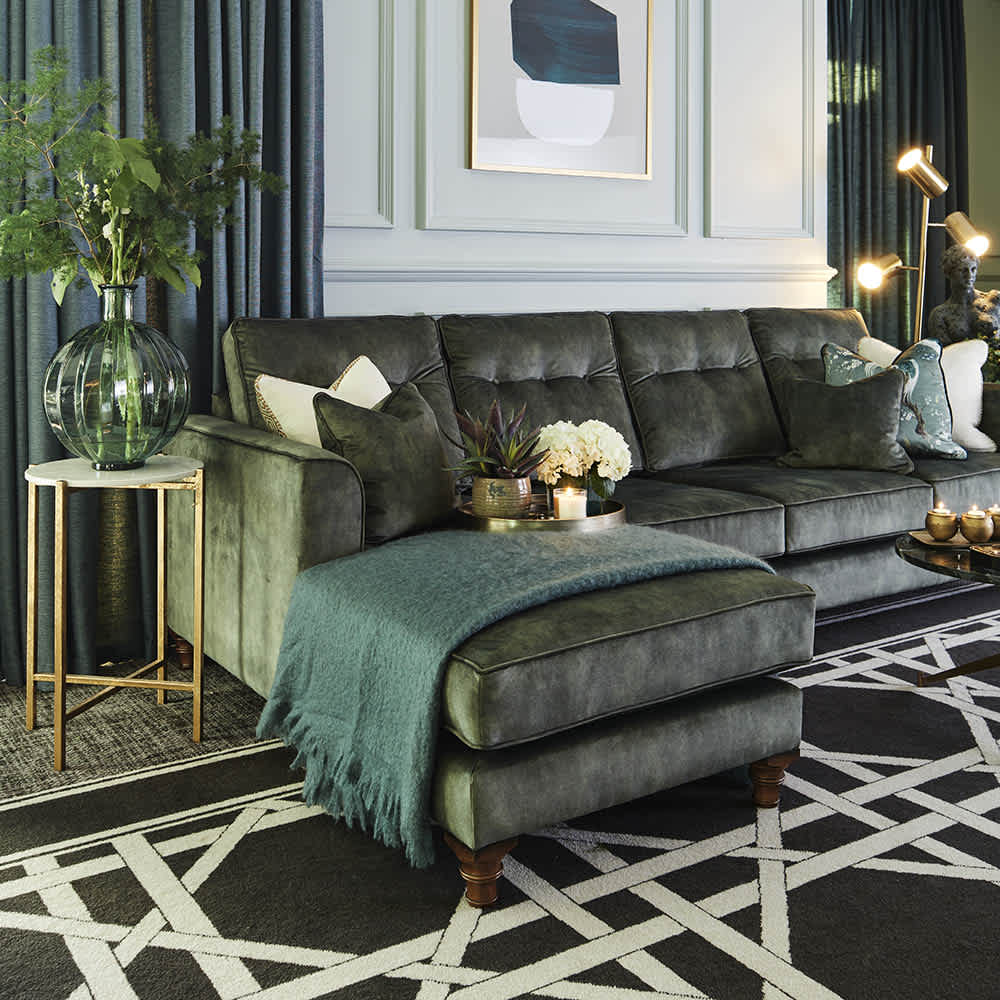
Modern living room with a dark green handcrafted sectional sofa, geometric patterned carpet, and elegant decor reflecting contemporary Irish interior design
Cost Considerations and Long-Term Value
Financial considerations play a crucial role in furniture selection decisions, extending beyond initial purchase prices to encompass long-term ownership costs, maintenance expenses, and potential replacement timelines. A comprehensive cost analysis of velour versus eco-leather requires examining multiple factors that influence total ownership costs over the furniture’s expected lifespan.
Initial purchase prices for quality velour and eco-leather furniture often fall within similar ranges, though significant variations exist based on construction quality, design complexity, and manufacturer specifications. Velour furniture may offer slightly lower entry prices in some categories, while eco-leather pieces might command premium pricing due to advanced manufacturing processes and performance characteristics.
Maintenance costs represent a significant differentiator between these materials over time. Velour’s requirements for regular professional cleaning, specialized stain treatments, and potential pile restoration create ongoing expenses that accumulate significantly over the furniture’s lifespan. Professional cleaning services for velour furniture typically cost more than routine maintenance for eco-leather pieces due to the specialized techniques and products required.
Eco-leather’s maintenance cost advantages extend beyond professional cleaning requirements. The material’s resistance to stains and damage reduces the likelihood of costly repairs or premature replacement. Simple cleaning products available for household use prove adequate for most maintenance needs, eliminating the need for specialized treatments that velour often requires.
Longevity considerations strongly favor eco-leather in most applications, with quality pieces often maintaining their appearance and functionality for significantly longer periods than comparable velour furniture. This extended lifespan translates to better cost-per-year value, even when initial purchase prices might be higher.
Resale value considerations also merit attention, particularly for consumers who regularly update their furniture selections. Eco-leather furniture typically retains value better than velour pieces, partly due to its better preservation of appearance over time and broader appeal among potential buyers who prioritize practical characteristics.
However, certain market segments continue to value velour’s luxury characteristics sufficiently to support strong resale values for well-maintained pieces. Antique and high-quality traditional furniture upholstered in velour can appreciate in value, particularly when properly preserved and maintained throughout their ownership period.
Making the Right Choice for Your Lifestyle
The decision between velour and eco-leather ultimately depends on honest assessment of lifestyle factors, usage patterns, and personal priorities that will influence long-term satisfaction with the furniture investment. No single material proves superior in all applications, making thoughtful consideration of individual circumstances essential for optimal outcomes.
Households with young children benefit significantly from eco-leather’s practical advantages, particularly its stain resistance and ease of cleaning. The material’s durability ensures that furniture maintains its appearance despite the inevitable spills, food crumbs, and active play that characterize homes with children. The health benefits of reduced allergen retention also support eco-leather selection for families with sensitive members.
Pet ownership represents another factor that strongly favors eco-leather selection. The material’s resistance to scratching, easy cleaning, and reduced odor retention make it far more suitable for homes with cats or dogs. While no upholstery material is completely pet-proof, eco-leather offers the best combination of durability and maintenance ease for pet-owning households.
Formal entertainment patterns might favor velour in specific applications, particularly in homes where furniture serves primarily decorative purposes or receives minimal daily use. The material’s unmatched luxury appearance and comfort can create impressive formal spaces that reflect sophisticated taste and attention to quality.
Individual sensitivity to texture and comfort also influences optimal material selection. Some people find eco-leather’s surface less appealing for extended contact, while others prefer its consistent temperature and easy maintenance. Personal preference testing through furniture showroom visits can provide valuable insights into comfort preferences that specifications alone cannot convey.
Budget considerations must encompass both initial costs and long-term expenses to provide accurate comparison bases. While velour might offer lower initial costs in some categories, the total cost of ownership often favors eco-leather due to reduced maintenance expenses and longer replacement intervals.
Environmental and Sustainability Considerations
Modern furniture purchasing decisions increasingly incorporate environmental impact assessments that extend beyond immediate personal benefits to consider broader sustainability implications. Both velour and eco-leather present distinct environmental profiles that conscientious consumers should understand when making informed choices.
Eco-leather’s environmental advantages begin with its production process, which typically avoids animal products while often incorporating recycled materials. Advanced manufacturing techniques reduce waste and energy consumption compared to traditional leather processing, while eliminating the environmental impacts associated with livestock raising for hide production.
The longevity characteristics of eco-leather also contribute to environmental benefits through reduced replacement frequency. Furniture that maintains its appearance and functionality longer reduces the environmental impact associated with manufacturing, transportation, and disposal of replacement pieces. This extended lifespan multiplies the environmental benefits throughout the product’s lifecycle.
Velour’s environmental profile varies significantly based on fiber composition and manufacturing processes. Natural fiber velours may offer better end-of-life biodegradability, while synthetic versions provide durability advantages that extend usable life. The material’s maintenance requirements, including professional cleaning chemicals and energy consumption, must be factored into environmental impact assessments.
Disposal considerations also merit attention when evaluating environmental impacts. Eco-leather’s synthetic composition may present recycling challenges, though some manufacturers have developed take-back programs that address end-of-life disposal responsibly. Velour disposal depends heavily on fiber composition, with natural fibers offering better biodegradability than synthetic alternatives.
Local manufacturing considerations play increasingly important roles in environmental impact assessments. Irish and European-manufactured furniture reduces transportation environmental costs while supporting regional economies. Both velour and eco-leather options are available from European manufacturers, allowing environmentally conscious consumers to minimize transportation impacts while supporting local industry.
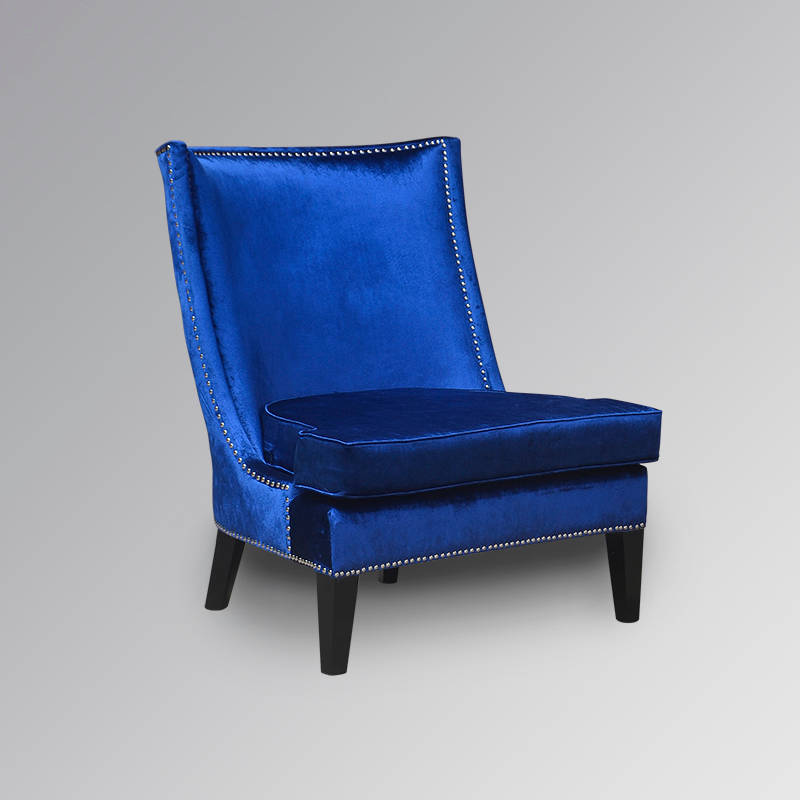
Louis XV accent chair with black frame and nautical blue velour velvet upholstery featuring silver nailhead trim
Conclusion: Informed Decisions for Beautiful, Functional Homes
The choice between velour and eco-leather for furniture upholstery represents more than a simple material preference – it reflects a complex decision that balances aesthetic desires, practical requirements, financial considerations, and lifestyle factors that will influence satisfaction for years to come. Both materials offer distinct advantages that make them optimal choices in specific applications and circumstances.
For most Irish households, eco-leather emerges as the superior choice for high-traffic living areas where durability, maintenance ease, and stain resistance provide daily benefits that enhance quality of life. The material’s sophisticated appearance, combined with practical advantages, makes it particularly suitable for contemporary lifestyles that demand both style and functionality from furniture investments.
Velour maintains its position as the ultimate luxury option for bedroom applications and formal spaces where comfort and aesthetic impact take precedence over practical considerations. The material’s unmatched tactile appeal and visual luxury create environments that truly feel special and distinguished from everyday spaces.
The key to successful material selection lies in honest assessment of how furniture will be used, who will use it, and what priorities matter most in each specific application. Rather than seeking a single material solution for all furniture needs, the most satisfying approach often involves selecting different materials for different purposes based on their unique strengths and characteristics.
As the Irish furniture market continues evolving toward greater emphasis on sustainability, functionality, and long-term value, both velour and eco-leather will maintain important roles in meeting diverse consumer needs. The choice between them should reflect careful consideration of individual circumstances rather than broad generalizations about superior materials.
By understanding the distinct characteristics, advantages, and limitations of each material, Irish consumers can make informed decisions that result in furniture selections that provide years of satisfaction, beauty, and functionality that enhance daily life while reflecting personal style and values.
